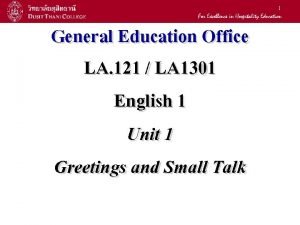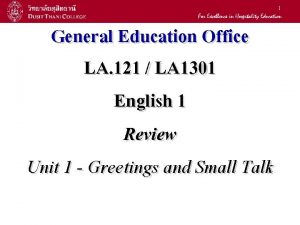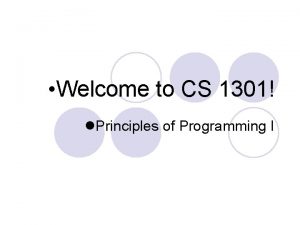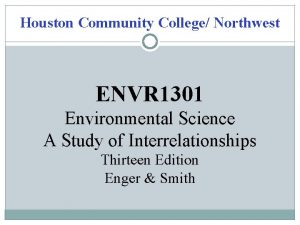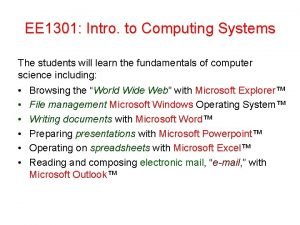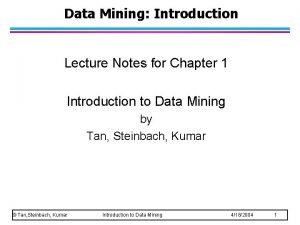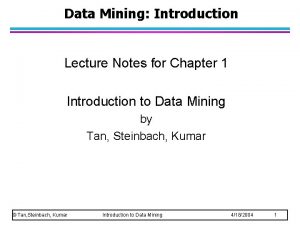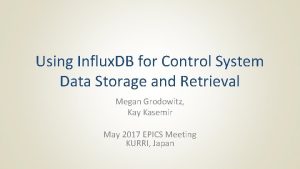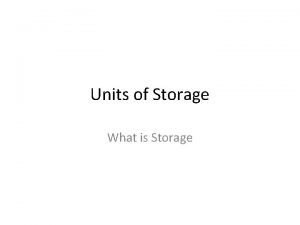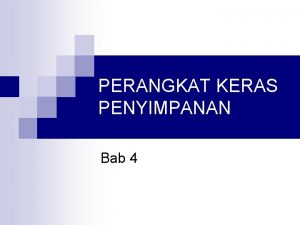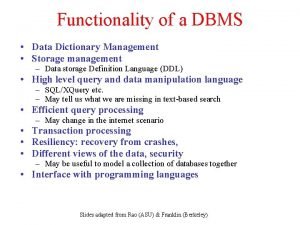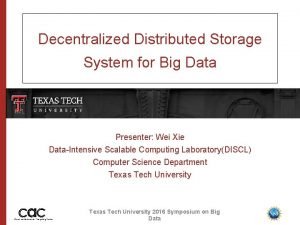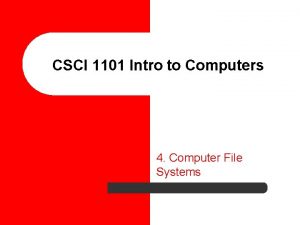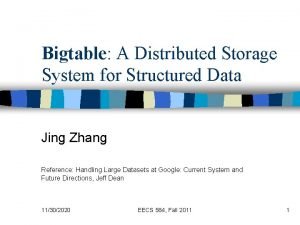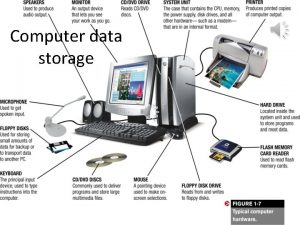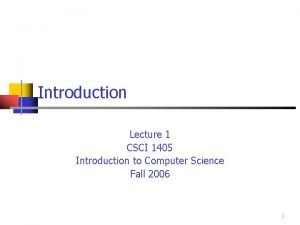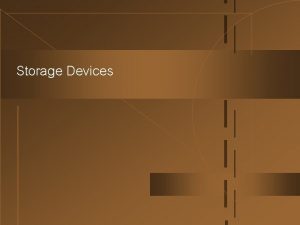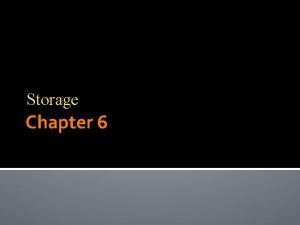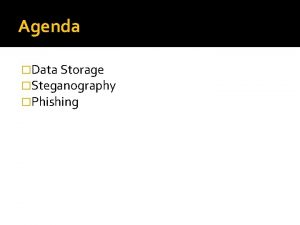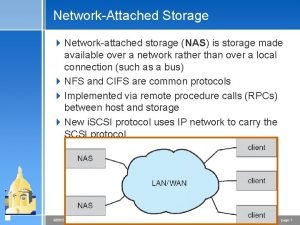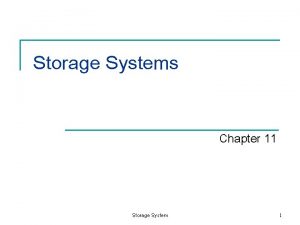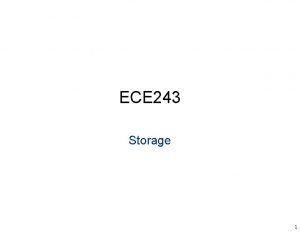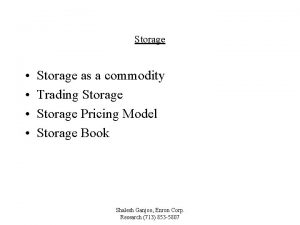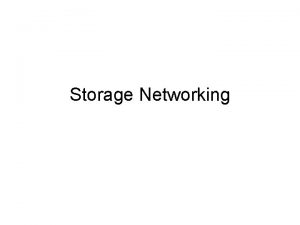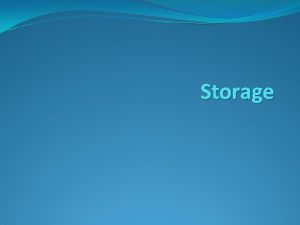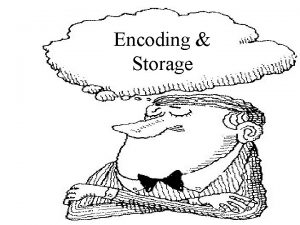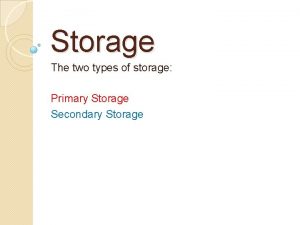Data Storage Lecture 3 CSCI 1405 CSCI 1301




























- Slides: 28

Data Storage Lecture 3 CSCI 1405, CSCI 1301 Introduction to Computer Science Fall 2009

Main memory cells • Cell: A unit of main memory (typically 8 bits which is one byte)

Main memory & address

Memory techniques • Random Access Memory (RAM): Memory in which individual cells can be easily accessed in any order • Capacity: – Kilobyte: 210 bytes = 1024 bytes ~ 103 – Megabyte: 220 bytes = 1, 048, 576 bytes ~ 106 – Gigabyte: 230 bytes = 1, 073, 741, 824 bytes ~109

Mass Storage (Secondary Storage) 1. 2. 3. • • • Magnetic Systems (Disk, Tape) Optical Systems (CD, DVD) Flash Drives Larger capacity Less volatility Slower: Requires mechanical motion- more time On-line: connected and readily available to the machine Off-line: requires human intervention before being accessed

Magnetic systems Two kinds: 1. sequential access secondary storage: searching for a certain data means starting from the beginning of the file sequentially till the data is reached ( like magnetic reel tape and cassette ) 2. Direct access secondary storage: Data can be reached directly without going through the stored data (like magnetic disk )

Magnetic Disk • The most widely used storage medium in computers today • Data is stored by magnetizing particles on the storage medium. • Capacity of disk storage system depends on the number of disk used and the density in which the tracks and sectors are placed – Lower-capacity system consists of a single plastic disk known as diskette or floppy disk (off-line storage). 3 1/2 inch have a capacity of only 1. 44 MB – High capacity system like hard-disk (consist of 5 -10 rigid disks mounted on a common spindle )

Magnetic Disk • • • Head, track, sector, cylinder Access time = Seek time + Rotation delay/latency time Transfer rate: the rate at which data can be transferred to or from the disk


Floppy Disks and Drives – Single plastic flexible disk – Typically 3½ inches in diameter. – Typically hold 1. 44 megabytes. – Inserted into floppy disk drive to be read from or written to.


Floppy Disks and Drives, Cont’d. • Disk is divided into tracks, sectors, and clusters.


Hard Disk System: • Usually (5 -10) rigid disks mounted on a common spindle and combined into a disk pack • Disk drive - a device that allows data to be read from or written to a disk • Disk drive for personal computers contained within computer housing • Can be internal or external. • Large computer systems may have several external disk drives • Capacity in gigabytes • Accessing files much faster than accessing files on diskettes


Disk Packs • Each disk has its own access arm with read/write head • Most disk packs combine disks, access arms, and read/write head

Reading/Writing Data • Access arm moves read/write head over particular location • Read/write head hovers a few millionths of an inch above disk and doesn’t touch the surface of the disk. – If head touches platter, a head crash occurs and data is destroyed – Data can be destroyed if head touches miniscule foreign matter on surface of disk

How Data Is Organized into tracks, sectors, clusters, and cylinders • Track • Sector • Cluster • Cylinder

Disk Access Speed • Access time - the time needed to access data on disk • Three factors – Seek time – Head switching – Rotational delay • Once data found, next step is data transfer

Optical Systems: Like Compact Disk (CD): • These disks are 12 cm (approximately 5 inches) in diameter and consist of reflective material covered with a clear protective coating • The capacity of the CD about 600 to 700 MB. • Information is recorded on them by crating variations in their reflective surfaces. • This information can be retrieved by means of a laser beam. That monitors irregularities on the reflective surface of the CD. (Laser scans disk and picks up light reflections from disk surface)

CD storage

Optical Systems: • Information on these CDs is stored on a single track that spiral around the CD, this track divided into units called sectors. Each with its own identifying marking s and a capacity of 2 KB of data • The distance around the spiraled track is greater from the outer edge of the disk than the inner portion • To maximize the capacity of a CD: information is stored at a uniform linear density over the entire spiraled track which means that more information is stored in a loop around the outer portion of spiral than in a loop around the inner portion

Optical Systems: Compact Disks Categorized by read/write capability: • CD-ROM - drive can only read data from CDs – stores up to 700 MB per disk – Primary medium for software distribution • CD-R - drive can write to disk once – Disk can be read by CD-ROM or CD-R drive • CD-RW - drive can erase and record over data multiple times – Some compatibility problems trying to read CD-RW disks on CD-ROM drives

Optical Systems: Digital Versatile Disk (DVD) • Constructed from multiple, semi-transparent layers – DVD drive can read CD-ROMs – Capacity up to 17 GB – Allows for full-length movies – Sound is better than on audio CDs • Several versions of writable and rewritable DVDs exist

Flash memory media • Bits are stored by sending electronic signals directly to the storage medium where they causes electrons to be trapped in tiny chambers of silicon dioxide.

Flash memory media • Flash memory media, cont’d. – Common forms of flash memory: • Flash memory sticks and cards. Commonly used with digital cameras, digital music players, handheld PCs, notebook computers, smart phones, etc. • Flash memory drives, such as USB flash drives. – with capacities of up to a few GB, are available for general mass storage applications – packaged in small plastic cases approximately three inches long with the removable cap on one end to protected the unit's electrical connector when the drive is off-line


Thank You
 Amir temur tuzuklari davlat boshqaruvi
Amir temur tuzuklari davlat boshqaruvi La 1301
La 1301 La 1301
La 1301 General education movie
General education movie Cs 1301
Cs 1301 Envr 1301
Envr 1301 Ee 1301
Ee 1301 Arts 1301
Arts 1301 Chickens never wear shoes movie genre
Chickens never wear shoes movie genre Secondary storage vs primary storage
Secondary storage vs primary storage 01:640:244 lecture notes - lecture 15: plat, idah, farad
01:640:244 lecture notes - lecture 15: plat, idah, farad Storage devices of computer
Storage devices of computer Secondary storage provides temporary or volatile storage
Secondary storage provides temporary or volatile storage Object based and unified storage
Object based and unified storage Exploratory data analysis lecture notes
Exploratory data analysis lecture notes Bayesian classification in data mining lecture notes
Bayesian classification in data mining lecture notes Data mining lecture notes
Data mining lecture notes Data visualization lecture
Data visualization lecture Data mining lecture notes
Data mining lecture notes Data mining lecture notes
Data mining lecture notes Influxdb data storage
Influxdb data storage Bits bytes kilobytes
Bits bytes kilobytes Contoh secondary storage
Contoh secondary storage Extensive network data storage (nds)
Extensive network data storage (nds) Select product1.* from product1 product2
Select product1.* from product1 product2 Distributed storage in big data
Distributed storage in big data A named collection of data on a storage medium
A named collection of data on a storage medium Bigtable a distributed storage system for structured data
Bigtable a distributed storage system for structured data Data-centric storage
Data-centric storage

